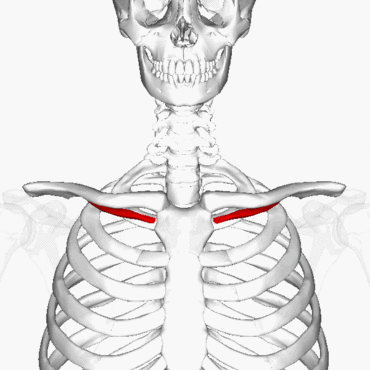Subclavius
Original Editor - Alyssa Brooks-Wells
Top Contributors - Alyssa Brooks-Wells
Description[edit | edit source]
The subclavius is a small, triangular muscle in the anterior thorax located between the clavicle and the first rib. [1]
Origin[edit | edit source]
The subclavius originates on the upper border of the first rib and its cartilage.[2]
Insertion[edit | edit source]
The subclavius inserts on the inferior surface of the middle third of the clavicle in a bony groove. [2]
Nerve[edit | edit source]
The subclavius is innervated by the nerve to the subclavius, a branch of the brachial plexus. The nerve to the subclavius originates from the C5-C6 nerve roots. It has been argued that because the subclavius muscle has a specific branch of the brachial plexus that is not shared by another muscle, the function of providing information about the upper extremity is more important than originally hypothesized. [1]
Artery[edit | edit source]
The subclavius is supplied by the clavicular branch of the thoracoacromial trunk. [2]
Function[edit | edit source]
The subclavius depresses the clavicle as well as helps stabilize the sternoclavicular joint. The subclavius is enveloped in the clavipectoral fascia along with the pectoralis minor, coracobrachialis, and short head of the biceps.[1]
One cadaveric study found the muscle contributes to the control of the position of the scapula in relation to the thorax via the lateral aponeurotic extension and fascial connections. This aponeurotic extension was found to be more prevalent than previously documented. As the size of the clavicle determines the distance between the sternoclavicular and the acromioclavicular joints the contraction of the subclavius does not shorten this distance. Because of this, the contraction of the muscle is hypothesized to increase tension at the tendinous border and the aponeurosis. The authors suggested that because of the anatomical variations and innervation, the subclavius most likely regulates the output of kinetic energy of the upper extremity's movement rather than acting as a muscle of stabilization.[1]
Clinical relevance[edit | edit source]
The subclavius may be a culprit of compression of the brachial plexus and contribute to neurogenic thoracic outlet syndrome with overhead positioning as the costoclavicular space is narrowed. [3]
The subclavius helps to aid in preventing dislocation of the clavicle at the sternoclavicular joint. It also can protect the neurovascular structures beneath it in the event of a clavicular fracture.[4]
Myofascial pain or muscle strain of the subclavius may result in pain along the clavicle, sternoclavicular joint, shoulder, or radiate into the arm. Pain in the muscle may result from heavy lifting, chronic forward shoulder positioning, using a heavy backpack or strap across the clavicle or side-sleeping with the upper extremity positioned overhead.[4]
Resources[edit | edit source]
- ↑ 1.0 1.1 1.2 1.3 Crepaz-Eger, U., Lambert, S., Hörmann, R., Knierzinger, D., Brenner, E. & Hengg, C. The anatomy and variation of the coracoid attachment of the subclavius muscle in humans. Journal of Anatomy. 2022;240:376–384.
- ↑ 2.0 2.1 2.2 Netter FH. Upper Limb. In: Hansen JT editor. Atlas of Human Anatomy. Philadelphia: Saunders Elsevier, 2014. p519.
- ↑ Liu Y, Zhang Z, Wang J, Wu G, Yu W, Cui S. Improved functional outcome in NTOS patients following resection of the subclavius muscle with radiological signs of nerve impingement: indication of participation of the subclavius in brachial plexus compression. Journal of Neurosurgery JNS. 2019;131:1541-1551.
- ↑ 4.0 4.1 Park A. Subclavius Muscle Pain [Internet]. Musclepain.org. 2022 [cited 27 December 2023]. Available from:https://musclepain.org/subclavius-muscle-pain/







